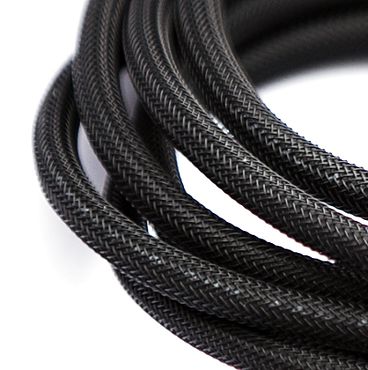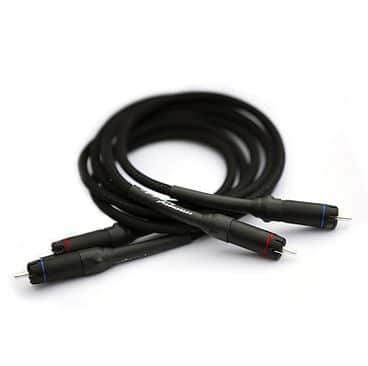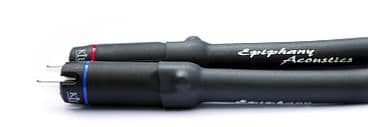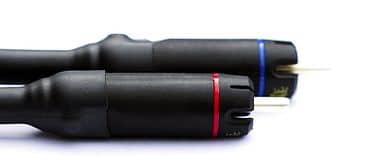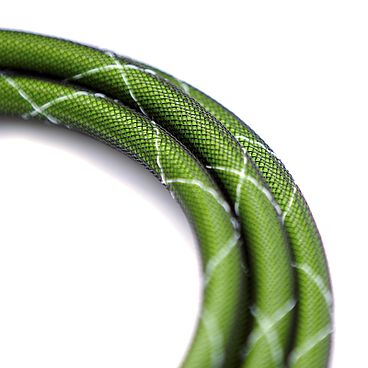The Article
Epiphany Acoustics’ Atratus II and Atratus III interconnect cables: Reaching An Epiphany
2nd May 2015
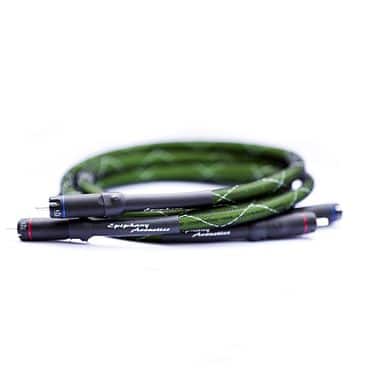
Targeting the budget end of the cable market, Paul Rigby reviews Epiphany Acoustics’ Atratus II and Atratus III interconnect cables
Everyone’s a hi-fi expert, it seems. More so when it comes to cables. Many are not convinced that cables add to (and, on occasion, remove from) the sonic experience. Despite the fact that the music, that will reach your ears, travels down these cables. In the same way that this same musical signal travels down other cables and bits of wire that sit within amplifiers, CD players and the like. Maybe if cables were sold within wacking great steel chassis boxes then the naysayers would give them some respect?
Saying that, I must admit that I too used to be a cable cynic. I ‘decided’ (based on zero evidence) that cables had no effect. And so that was that. I looked upon my hi-fi system and founded it ‘good’, to paraphrase a religious connotation.
Eventually, I set up my own test. I did an A-B of my own. Using varying types of hi-fi kit and different musical genres. Suffice to say that, blow me down with an interconnect, I could hear differences, sometimes big differences. The more cables I listened to, the more differences I heard.
You know what, though? While some cables were excellent, others were very poor. Some offered a major enhancement to my hi-fi kit, others provided little improvement, others no difference at all. Some cables affected some hi-fi chains more than others.
In short, they acted like any other hi-fi peripheral.
So how would the new Epiphany Atratus II cables respond to my own hi-fi reference kit? My tests duplicated that of a raw beginner. I ran a range of kit: amps, DACs, pre-amps and more using nothing but a piece of ‘bell wire’, the sort of thin and rather horrible wire (I won’t even call it cable) that is given away free in entertainment systems and the majority of budget hi-fi.
Playing the 24bit/192kHz version of Big Bad Girl, sung by blues man, Harry ‘Bid Daddy’ Hoplite, via a Concord DAC 1, the vast amount of information, that I knew was there, just could not get through the bell wire. To say that the sound was constricted was a severe understatement. Hoplite sounded as if he was singing, scrunched in a chair, with his shoulders up around his ears, tensing the muscles in his face and was worried sick about a new tax bill that he’d received that morning. His mind was not on his work. It was not pretty.
Putting the new Atratus II cables in the system, relaxed the entire demeanour of the poor guy. Not only did he unwind, he sounded – for the first time – that he was actually enjoying himself. I could actually hear some emotion from his delivery while the guitar opened up from the cheap and nasty instrument of the bell wire performance to a fuller, more expansive instrument via the Atratus II.
Putting the 16bit/44.1kHz WAV rip of the Skunk Anansie track, Hedonism, through the Atratus II cables, allowed me to hear the nuance of, lead singer, Skin’s powerful vocalisations while the force of the guitar during the chorus hit me with wallop. Previously, the bell wire had the music struggling to crawl to my ears. Instead of a restrained, rather ‘pleasant’, rhythm guitar I now heard a strong and powerful musical weapon offering textural detail in abundance.
If you have a system that still retains the basic bell wire then you really need to grab a suite of these Atratus II interconnects. There’s plenty of information that’s desperately trying to get out but the bottleneck, provided by the bell wire, is stopping it.
Of course, if the Atratus II is not enough for you, then consider the slightly more expensive Atratus III interconnects instead.
What do the IIIs give you that the Atratus IIs do not? The III enlarges the soundstage, opening up the performance to a grander level. There’s a more obvious performer/listener boundary here, a sort of audience/stage effect while the vocal delivery of Hoplite is slightly more mature with a rounded, fuller suite of lower registers and a laid back and confidant air about his singing. The guitar, meanwhile, offers far more detail, especially in the attack of the strings. When Hoplite hits the guitar strings on the downward passage of the strum, there is more information on this part, via the IIIs.
The same can be said from the up-tempo rock track, Hedonism. More emotion can be heard from Skin’s now increasingly emotionally fragile delivery while the percussion offers a weightier heft. Meanwhile, the guitar cuts across those essential power chords with determination and purpose.
CONCLUSION
Both of these cables offer two excellent features. Firstly, they both offer superior sound quality, when compared to the normal bundled bell wire, opening up that frustrating sonic bottleneck and allowing you to hear just what your hi-fi is capable of plus, just as importantly, they provide top value for money. These cables remain in the affordable bracket. A relative rarity in the hi-fi market. If you’ve never upgraded your cables, buying a suite of Atratus IIs is a real no-brainer. If you want to upgrade your cables from budget models then give the Atratus IIIs a listen, you might just be surprised. In fact, for many, these will be the only cables you will ever need.
EPIPHANY ACOUSTICS ATRATUS II
Price: £65 for 1m
Website: epiphany-acoustics.co.uk
GOOD: musicality, upper midrange insight, texture and value for money
BAD: nothing at the price
RATING: 8
EPIPHANY ACOUSTICS ATRATUS III
Price: £100 for 1m
Website: epiphany-acoustics.co.uk
GOOD: expansive soundstage, detailed upper bass region, midrange attack and value for money
BAD: nothing at the price
RATING: 8
CONTACT:
Epiphany Acoustics
epiphany-acoustics.co.uk

